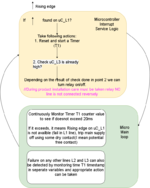vishweshgm
Member level 4

- Joined
- Dec 17, 2021
- Messages
- 74
- Helped
- 5
- Reputation
- 10
- Reaction score
- 7
- Trophy points
- 8
- Activity points
- 952
Hi,
I want to design a system to detect phase reversal (in a 3phase systeM) and correct it. 3 phase line is fed to a 3phase 10HP motor (Input AC Line voltage is rms 110v/50Hz) and hence all 3 phase sequence must be maintained even if someone connects L1,L2,L3 incorrectly. I looked online for ideas but I could find ideas for detection but not correction. I guess, we need a set of contact relays which needs to be controlled using micrcontroller based on detection of phase in each line fed-in. So here is the unit block diagram in my mind:

I have some ideas for phase monitor using micro controller (like using 3 opto couplers to detect zero crossing time and taking the time difference between all 3 to find if the phase is in sequence. I am yet to finalize logic though). But I need your help to see if correction unit can be implemented practically. Kindly suggest ideas/links if anyone already implemented it.
I want to design a system to detect phase reversal (in a 3phase systeM) and correct it. 3 phase line is fed to a 3phase 10HP motor (Input AC Line voltage is rms 110v/50Hz) and hence all 3 phase sequence must be maintained even if someone connects L1,L2,L3 incorrectly. I looked online for ideas but I could find ideas for detection but not correction. I guess, we need a set of contact relays which needs to be controlled using micrcontroller based on detection of phase in each line fed-in. So here is the unit block diagram in my mind:
I have some ideas for phase monitor using micro controller (like using 3 opto couplers to detect zero crossing time and taking the time difference between all 3 to find if the phase is in sequence. I am yet to finalize logic though). But I need your help to see if correction unit can be implemented practically. Kindly suggest ideas/links if anyone already implemented it.




